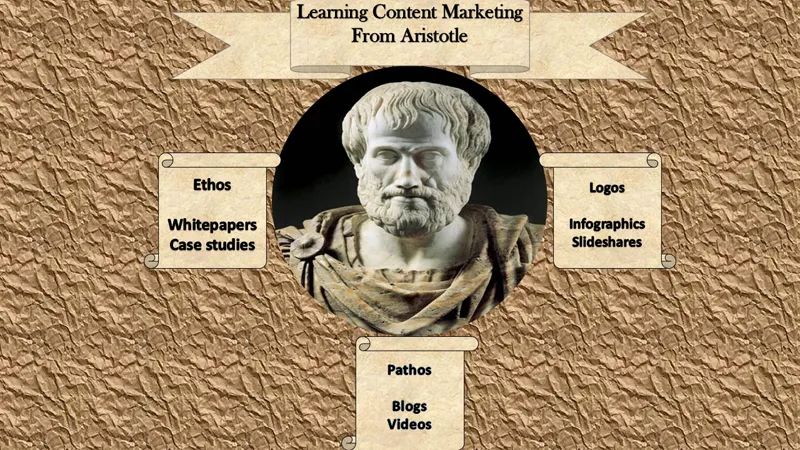What startups can learn about content marketing from Aristotle
Many people prefer to read visually. On an average it takes 250 words to describe what a picture says effortlessly: the context is about setting the mood and the import. Yet when it comes to how we display information within our enterprise, and about our enterprise, some of us tend to be stuck on text and spreadsheets.
Let’s remember that some of the most effective pieces of communication were spawned long before the internet. It was in ancient Greece that Aristotle developed the essential elements of reasoning - logos, pathos, and ethos. In order to produce effective communication or content all the three (Logos - the logical side of reasoning; Pathos - the emotional side of reasoning; and Ethos - the ethical side of reasoning) have to be fully integrated.

Aristotle's golden rules apply even today. Every content and communication expert is looking at changing someone’s mind about something; hence, the content has to be very persuasive. So, while every entrepreneur would love to populate cyberspace with information about his or her own business, there’s no better way to begin than by integrating all three elements into the content itself.
Here are five quick ways your small startup team can churn out great content and become a mean marketing machine.
Starting with Aristotle’s Logos, let us examine infographics and slideshares.
Infographics
They work because infographics hold a strange power over us. They engage the brain by straddling the space between creativity and logic. They are the fastest way to digesting facts and learning something new; e.g. how high heels can damage your feet.
While making one, keep in mind that the infographic shares a message that is both dramatic and of interest. To make an infographic interesting, the important things to remember are: overview a subject, simple treatment and great navigable design.
It is a good option in two types of cases: 1) for products that are aimed at an informed audience, and 2) for getting hard facts across in an engaging manner.
Slideshare
They work because a slideshare is a good form of presentation. Besides, due to its utility value in SEOs, it makes frequent appearances in online news and receives a large volume of inbound interest.
While making one, keep in mind that a slide deck can cover a whole topic. The breaking-down of a topic into slide-sized chunks helps readers digest the content easily. Make it visual and keep it short; ideally around 12 to 15 slides.
This is a good option in three different scenarios: 1) when you want to make a ‘how to’ guide; 2) when you want to state mission and vision statements in an easily understandable way, and 3) when you want to chronicle a period in a company’s history for posterity.
Now let us move on to Aristotle’s Pathos, in discussing blogs and videos.
Blogs
They work because there’s no better way to put out an argument. Interspersed with pictures, graphs, memes, videos, and even gifs, blogs are your own private digital medium. It allows you to choose the comments you will allow and the ones you won’t.
While making one, keep in mind that you should make one strong argument per post. Drive the subject emotionally. Stick to about 300 or 400 words, with at least two visual elements.
This is a good option as an ‘image building’ exercise. Blogs are the next best thing to having your own book. So, just as published authors are rated highly as subject matter experts, a good regular deep-rooted blog comes close to being considered a subject matter expert, too.
Videos
They work because videos require the least effort from their viewers when it comes to consumption. Videos captivate audiences in a way static text simply cannot. Showing live demonstrations, vines, and visual storytelling requires a huge amount of information, and emotion.
While making one, keep in mind that a single message, delivered under 60 seconds; and that is friendly, approachable, and funny always works. Though production values have to be maintained, they should be light enough to be shared on WhatsApp and Twitter.
This is a good option when launching a product or explaining how it works. There’s no better way of storytelling than videos, as people in the entertainment industry will tell you. It also works well for educational products.
Finally, let’s move on to Aristotle’s Ethos, which positions you as a person with an ‘ethical right’ to comment on a subject.
Whitepapers and Case studies
They work because they build credibility with your audience. They stand testimony to your knowledge and establish your authority on a subject; and give you an ethical standpoint from which to comment on important subjects.
While making one, keep in mind that you should offer real solutions. Get into the dilemmas that people face in their everyday decision making. Offer illustrations. Offer data on your depth and reach, and allow people to navigate through your page to understand the solutions.
This is a good option when:
1) You're in the healthcare business or education business,
2) You have a new technology that people are hesitant to adopt, and
3) You want to establish trust and leadership.
We should all remember that a great content marketing strategy is not built around a few isolated publications; it has to be a continuous stream of great quality content over time.







